Letters from Lodi
An insightful and objective look at viticulture and winemaking from the Lodi
Appellation and the growers and vintners behind these crafts. Told from the
perspective of multi-award winning wine journalist, Randy Caparoso.
Deconstructing umami (in wine and food contexts)
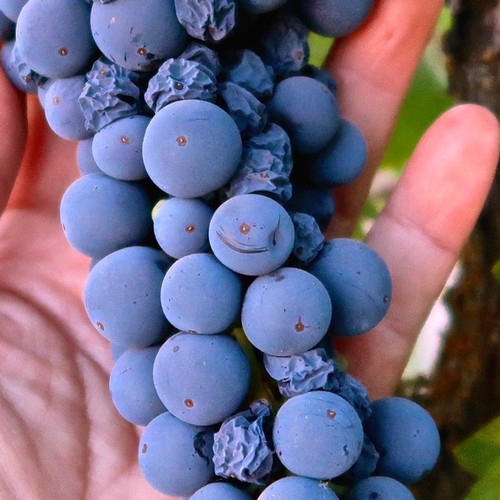
"Smiling" cluster of 2019 Lodi Zinfandel, with shriveling skins containing phenolic content (color, tannin, flavors) as well as underestimated amounts of amino acids enhancing the savory taste of umami on the palate
One of our most interesting recent wine and food experiences occurred just this past summer, when we hosted nine sommeliers from across the country, here to study Lodi winegrowing for three and a half days. Our opening night dinner took place at The Gypsy Bistro, a comfort food restaurant housed in one of what was once a long defunct co-op winery's gigantic cement fermentation tank.
On a lark we asked The Gypsy Bistro chef/owners to do a twist on one of their most popular dishes consisting of macaroni and three cheeses; only, we asked them to add fresh lobster and a sprinkle of cayenne so that we can do an experimental matching with two completely different wines: a lush, silky, barrel fermented Chardonnay and a moderately weighted but black pepper/kitchen spice scented Petite Sirah, both grown in Lodi (of course).
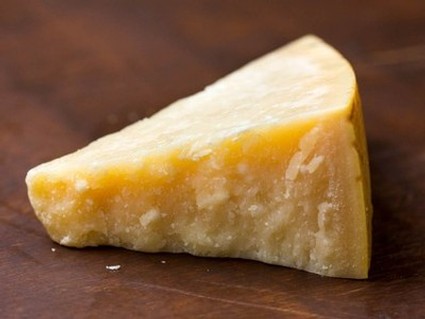
Parmigiano-Reggiano, an umami-rich "secret ingredient" bridging even lobster dishes with spicy red wines
When we drew it up, we had all the reason in the world to expect the Chardonnay's creamy textures to make a beautiful match with the lusciously creamy macaroni, cheese and lobster dish. As it turned out, virtually everyone at the table found that they much preferred the spicy red Petite Sirah with the lobster-mac, which was laced with a good proportion of Parmigiano. How could that be? Without a doubt it was mostly because of one sensory component often overlooked, but definitely found in many red wines, in lobster meat, as well as in many cheeses such as a well aged Parmigiano: a palate sensation called umami.
You may have heard of it. If not, what is umami and why should you care? Haven't foods and wines become complicated enough without having to understand one more odd sounding concept?
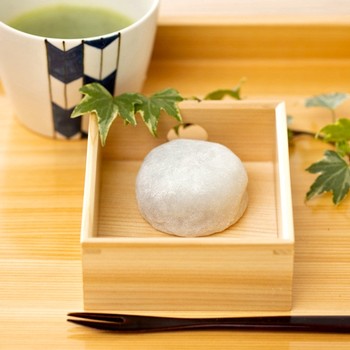
Natural umami enhanced combination: red bean filled mochi and green tea (image courtesy of japancentre.com)
Our simple answer is this: When you think of the many food and drink combinations that seem like the most natural in the world – like coffee and donuts, sushi and beer, rare tuna and light red wines, green tea and red bean mochi cakes, and even hot dogs with ketchup or a bag of corn chips downed with a classic cola – the assumption is these combinations work well because of the way various sensations of sweetness, saltiness, sourness, bitterness and occasionally hot spiciness come together pretty much in perfect harmony and balance.
But some time ago, food scientists came to another conclusion as to why we unconsciously enjoy so many combinations based upon the recognition of this distinct component called umami, found in many of the things (like hot dogs, corn chips, raw tuna, red wine, green tea, Japanese beans and sushi) we love to eat or drink.
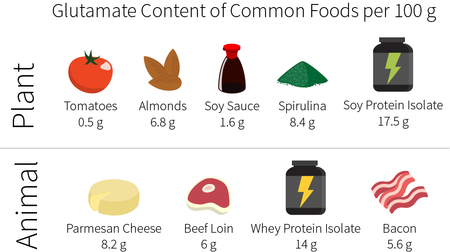
Foods that are high in glutamates, or amino acids, giving the sensation of umami (image courtesy of examine.com)
The taste of umami is less obvious than sweet, salty, sour, bitter or chili spice sensations. Umami more often manifests itself as an overall reaction on the palate to certain foods and beverages rich in amino acids, whether attained through cooking processes or activated by high amino acid ingredients already existing in certain foods. It is not, however, a textural quality (hard, soft, smooth, crunchy, etc.), but rather a "savory," "delicious" or somewhat “meaty” sensation.
According to the Japanese chemist (named Kikunae Ikeda) who made the first formal identification of umami back in 1908, umami is one of only two sensations (along with sweetness) that the palate perceives as pleasant. Sensations of salt, sour and bitter, on the other hand, are not pleasing in themselves, except when digested in moderation or experienced in the context of other sensations.
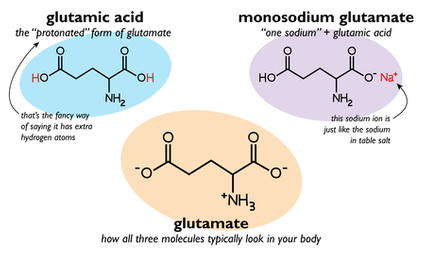
"Free glutamate" molecules that bind with umami-sensitive receptors on the palate
A common demonstration of umami's pleasing taste is a pinch of MSG (monosodium glutamate) – essentially a sodium salt of glutamic acid originally manufactured from seaweeds to stimulate high amino acid umami sensations – mixed into lukewarm water. What the palate feels is a stimulation of saliva, alerting the taste buds and tactile senses, giving a mouth-watering effect while boosting aroma-related sensations of flavor. Umami, in other words, enhances flavor, and can even make the blandest foods taste “delicious.” And, in fact, this is a reason why MSG is a key ingredient in many of our commercial packaged foods.
Lest there be any further misunderstanding, when we are talking about umami we are not just talking about a sensation found in foods or beverages. We are also talking about actual taste buds on the tongue that are particularly sensitive to umami, thus more likely to be stimulated by food components such as monosodium glutamate. Sugar tastes sweet, salt tastes salty, and high amino acid ingredients taste like, well, umami!
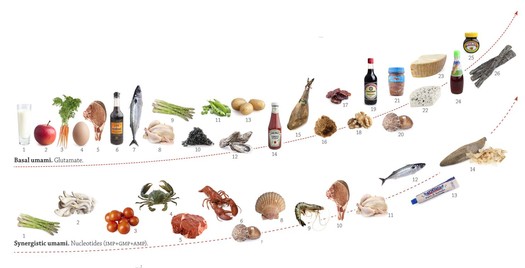
Umami-rich "chain of foods" (image from Umami by Ole G. Mouritsen & Klavs Styrbaek, courtesy of popsci.com)
In recent years two American scientists named Charles Zuker and Charles Ryber have identified these specific taste bud cells as “T1R1” and “T1R3” (without, however, pinpointing any specific area of the tongue where they are located) which, working in tandem, create palate receptors sensitive to umami -- particularly foods high in glutamates or amino acids.
When it comes to foods and wines, the perception of amino acid compounds occurs in many instances. While the taste of wines is primarily driven by components that are easily understood, such as the sweetness of residual sugar, the bitterness of tannin or sourness of acidity, wines also contain small amounts of amino acid, which add to the sensations giving us distinct pleasure.

Umami exponent Tim Hanni MW (image courtesy of thedrinksbusiness.com)
Within the wine industry, one of the earliest proponents of umami was a Master of Wine named Tim Hanni -- one of the more peculiar of our wine experts in that he doesn't drink wine (Hanni is, laudably, a survivor of alcoholism). But that doesn't mean Hanni can't taste wine and continue to influence many others. According to Hanni, only the phenomenon of umami explains the “deliciousness created by fermenting, curing and preserving" of certain foods.
Two easily understood examples: well matured cheeses like Italian Parmigiano-Reggiano or Pecorino, and cured meats like smoked bacon, lardons or Pancetta – all commonly used by cooks or at the table by consumers to enhance the flavor of dishes. What is spaghetti in tomato sauce (or, in our recent experience, a good ol' mac-cheese-and-lobster dish), for instance, without a heavenly shower of shaved Parmigiano? What are eggs, or the occasional cheeseburger, without crispy, smoky bacon? It's the sensation of umami common to ingredients in these foods that makes it all work.
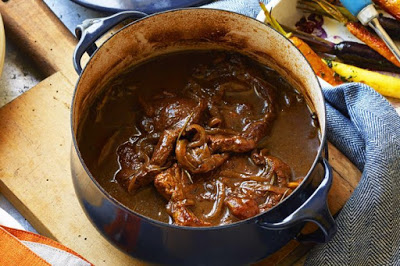
Traditional French pot-a-feu: a concentration of umami through the slow cooking process of beef, vegetables and stock (image courtesy of taste.com.au)
As the result of cooking processes we enjoy in restaurants, complex, slowly evolved stocks derived from chicken, veal bones and shellfish, as well as the reductive aspects of slow cooking, pot-a-feu (traditional French beef stews), nages (infused broths) and natural essences, are all achieved by elevated degrees of umami. Then again, so does the blatant appeal of chicken fried with secret recipes consisting of eleven herbs and spices. Wily professionals bind sauces, broths, and even vinaigrettes with umami intense ingredients such as dried shiitake mushrooms, truffles, and vine ripened tomatoes; while an instant home cook might reach for cubes of bouillon (in which a primary ingredient is umami stimulating MSG) to enhance a slow cooked dish.
In fact, the late, great, puristic Italian cookbook author Marcella Hazan made no bones about using il dado (the bouillon cube) to help turn "water into broth" in order to round out the taste of a soup or risotto. It's not so much a matter of if-it's-good-enough-for-Marcella-it's-good-enough-for-me as simply all about umami. When you cook with an umami thought process, it works.
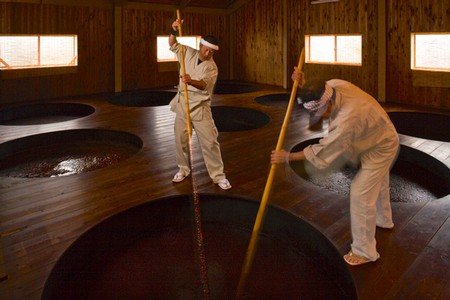
The brewing of Tamari's artisanal Japanese soy sauce from glutamate-rich soy beans (image courtesy of Japan Brand)
Not surprisingly, it is in Asian cuisines -- in which ingredients and cooking techniques are often very simple or understated, but very strong in the sum total of parts -- that umami naturally plays a significant role. Soy sauce, for one, is chock-full with amino acids, as are seaweeds, dried fish and fish stocks, as well as basic seasonings such as Japanese shichimi and Chinese five-spice. Umami plays a restorative role when dashi (a broth made with bonito flakes and dried kelp) is added to Japanese dishes, and conducts the electrical reaction of a dish on the palate when fish sauce or sambal (chile paste) is added to Southeast Asian dishes.
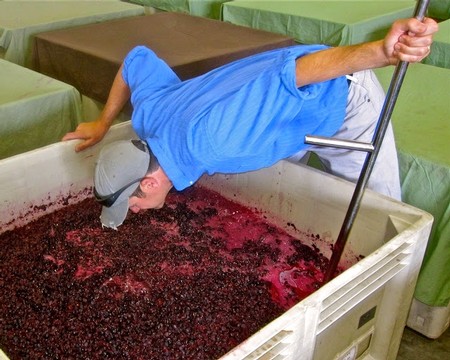
Lodi grown Zinfandel being fermented on its skins, producing both complex red wine flavor and the savory, amino acid driven sensations of umami
The significance of umami when it comes to wine is multifold. It goes a long way towards explaining why certain wines -- especially more complex and mature red wines in which amino acids are more in balance with other taste components -- seem to naturally relate to more foods. According to Fernanda Cosme in Journal of Food Science & Technology, "The major free amino acids found in the most varieties of Vitis vinifera grapes are arginine, proline, alanine and glutamic acid. Usually the highest concentrations are found in the final phase of the ripeness of the grapes (Klosse, 2013). Regarding to the distribution of the amino acid in the berry (sic), its predominance is verified in grape skin for Vitis rotundifolia (i.e. muscadine) grapes (Lamikanra and Kassa, 1999)."
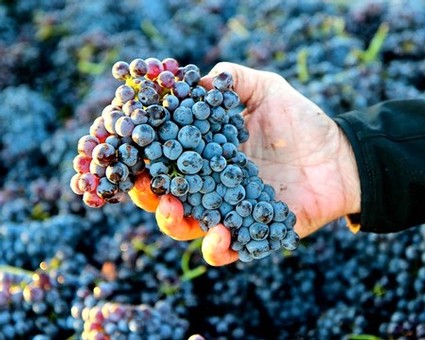
Lodi grown Grenache, producing a soft, balanced, spice scented and umami-food-versatile red wine
"In general," adds Pekka Lehtonen (Determination of Amines and Amino Acids in Wine), "red wines contain significantly more amines (contained in amino acids) than do white wines... Red wine contains 300 to 1300 mg/L of the most abundant amino acid, proline, which means that proline accounts for 30% to 85% of the total amino acid content. Next in abundance are alanine, glutamic acid + glutamine, arginine, and γ-aminobutyric acid."
In plainer English, it is red wines -- which, unlike whites, are fermented in contact with their grape skins where amines are concentrated -- that are more likely to give the taste of umami. This is why lighter tannin reds such as a soft, fruity yet multi-spice scented Grenache (a.k.a. Garnacha), Cinsaut, Pinot noir and even easier drinking styles of red Zinfandel, Mourvèdre or Petite Sirah seem to taste so good with, say, a wood grilled salmon or tuna steak. It also explains why smoother styles of reds are often amazingly simpatico with oysters, clams, mussels, squid, salt cod and other unlikely varieties of fish, especially in saffron laced bouillabaisse, bourrides, cioppino, and other seafood broths.
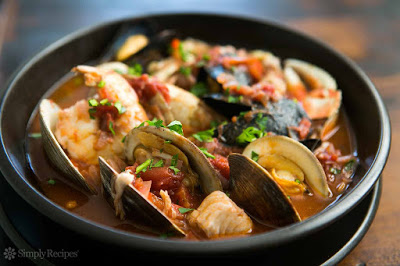
Classic cioppino: example of a multi-seafood dish more likely to go better with a red wine than a white because of high umami content
Umami, in short, is the factor behind the feeling of epiphany often experienced by wine lovers when they first come to the realization that many red wines go better with seafood dishes than most white wines!
What about blacker, heavier, stronger tannin and richly oaked red wines such as Cabernet Sauvignon, which are appreciated more for their power than their subtle, savory qualities? Years ago we conducted a fact-finding examination of the possibilities of pairing Cabernet Sauvignon with different foods. We tried salads, fish, mushrooms, game, beef, and even sweet/bitter chocolate desserts with a number of different Cabernet Sauvignons. Young and soft Cabernets, young and hard (high tannin) Cabernets, simple Cabernets, complex Cabernets, fruity Cabernets, earthy/leathery and strongly oaky Cabernets, plus an older, well-matured Cabernet. Some Cabernet Sauvignons worked better with certain dishes than others, but the one Cabernet that seemed to work better than all the others across the board was the richly matured, smooth and suave 10-year-old Cabernet Sauvignon, which happened to be grown in Alexander Valley (where many Cabernet Sauvignons are inherently softer in tannin).
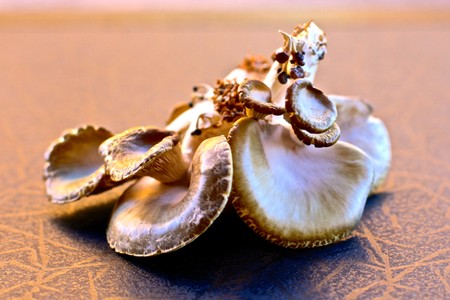
When wild mushrooms are employed in dishes, you are opening the door to balanced styles of umami-rich red wines, or more complext whites such as Chardonnay
Why? We would attribute this to umami-like effects: More specifically, the more mature, quietly balanced qualities of the well matured Cabernet Sauvignon allowed its amino acid content to play a bigger role in drawing out more savory sensations on the palate, thus allowing it to embrace a broader range of food sensations -- particularly dishes containing high umami ingredients (such as salads with ripe tomatoes and meats and game in high amino acid stocks and sauces).
Thus, when it comes to food preparations, the significance of umami determines how we choose many of our wines. Young, dense, strappingly intense Cabernet Sauvignons grown in the more shallow, phenolic concentrating gravelly clay loams of Napa Valley, for instance, are predictably good with simple cuts of wood charred beef. But if you braise beef with a myriad of seasonings and vegetables and serve it in a complex natural reduction, you are creating a high umami flavor “bridge” that is less welcoming to belligerently tannic Napa Valley Cabernet Sauvignons, as good as they may be.
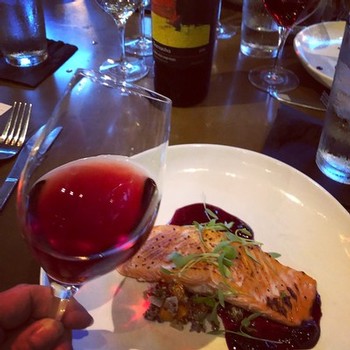
Recent umami-intense match: Bokisch's light and spice scented Garnacha with Scottish smoked trout in mixed berry gastrique served in Hawaii's Livestock Tavern
On the other hand, Lodi grown Cabernet Sauvignons -- particularly those grown in the higher vigor, deep, sandy loam soils of the Mokelumne River AVA -- tend to be softer and less intense than typical Napa Valley Cabernets Sauvignon, but this can be an advantage when it comes to braised beef and pot roasts: It is the rounder, less intense Cabernet Sauvignons that taste more savory with high umami roasts.
To demonstrate a reverse effect, Hanni likes to illustrate the effect of umami by citing the way a squeeze of lemon is traditionally used in a generously coarse salted bistecca alla fiorentina (beef raised and prepared in the traditional way of Tuscany in Italy) to activate salivation on the palate, and thus open up more complicated T1R1 and T1R3 receptors sensitive to umami. Hence, lemon juice balances salt, helps the palate absorb glutamate laced beef proteins and fats plus, just as importantly, mellows out bitter tannins and acid edges typical of forceful red wines made from grapes like Cabernet Sauvignon or Sangiovese. In this way, lemon brings out amino acids otherwise buried under the strong tannin, acid and oak of heavy reds. Salty beef, lemon and red wine? Definitely unorthodox (at least outside of Tuscany), but a graphic demonstration of what happens when umami sensations are released by something elemental, like lemon.
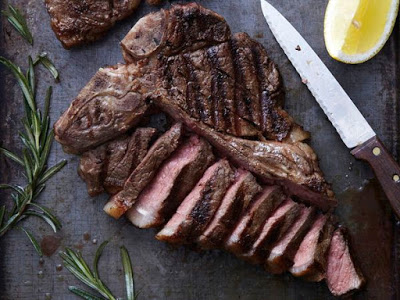
Tuscany's unorthodox (for Americans) way of serving beef: Bistecca alla Fiortina with coarse salt and lemon (image courtesy of saveur.com)
Because we don't habitually squeeze lemon on beef or have access to Tuscan bred cattle in the U.S., Hanni goes even further by recommending (brace yourself!) drinking White Zinfandel with American raised beef. Why? Because the slightly sweet fruitiness balanced by mildly acidic qualities in White Zinfandel are more likely to round out the fat and char of grilled beef, thus simulating the savory effect of umami.
Not for you? Relax, beef and Cabernet lovers. You needn't embrace all theoretical ramifications of umami. If you prefer your favorite brand of big, serious red wine with fatty beef or lamb, or a lemony dry white wine with your fish, other-white-meats or even red meats, the important thing is that you know what you like. In this respect – within the realm of personal taste -- umami is as much a state of mind as an actual taste sensation. We can all have good taste without having the same taste.
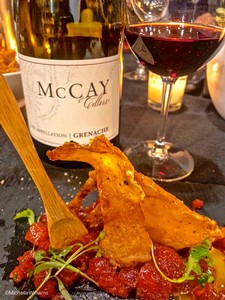
Another successful umami-rich match: tuna tartare with chicken skin chips served with a soft, sumptuous, earthy/spicy McCay Grenache at Lodi's M Sushi Bistro (image courtesy of Michelle Williams' Rockin Red Blog)
Still, it's good to know what umami is all about for the same reason why it's good to understand the use of spices and seasonings in your cooking. Or at the table, understanding which red wines are lighter, which ones are heavier, and what you actually prefer.
Bottom line: If a combination of foods (that is, if you consider wine -- in the old European tradition -- to also be a “food”) tastes perfectly good to you, then for all intents and purposes it is good. Often, in an umami sort of way.

Ancient Zinfandel vine (planting in 1901) growing in the deep, sandy loam soil of Lodi's Mokelumne River AVA, producing the type of round, sumptuous red wines ideal for umami-rich food contexts